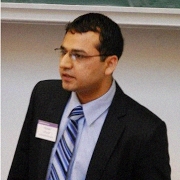Tutor HuntResources Medicine Resources
Validation Of New Image-derived Arterial Input Functions At The Aorta Using 18f-fluoride Positron Emission Tomography.
KEYWORDS mathematical modelling
Date : 06/10/2017
Author Information

Uploaded by : Tanuj
Uploaded on : 06/10/2017
Subject : Medicine
Abstract
OBJECTIVES:
(i) To validate two new image-based methods for finding the plasma arterial input function (AIF) and evaluate the performance of these and two similar techniques against arterial sampling. (ii) To evaluate the performance of all four image-derived AIF (IDAIF) methods against arterial sampling for measuring the F plasma clearance (Ki) to the lumbar spine.
METHODS:
Eight healthy postmenopausal women had a F-fluoride positron emission tomography scan of the lumbar spine. Venous blood samples were used to estimate the IDAIFs from: (i) a fixed population-based partial volume correction (PVC) factor method, (ii) a variable PVC factor method, (iii) the Chen method, and (iv) the Cook-Lodge method. Continuous arterial sampling and the respective Ki values were used as the gold standard against which the performance of the IDAIF methods was compared.
RESULTS:
The IDAIFs were compared with direct arterial sampling in terms of the area under the curve values. The percentage root mean square error in area under the curves compared with arterial sampling were: (i) fixed PVC: 12.7%, (ii) variable PVC: 12.0%, (iii) Chen: 39.0%, and (iv) Cook-Lodge: 17.3%. There were small but significant differences in the Ki values found by all four methods compared with arterial sampling. Bland-Altman plots of Ki values showed the best agreement for the variable and fixed PVC methods with a standard deviation of 0.0026 and 0.0030 ml/min/ml, respectively.
CONCLUSION:
The differences in the Ki values obtained at the lumbar spine using direct arterial sampling and any of the IDAIF methods at the aorta were clinically nonsignificant. The variable PVC and fixed PVC methods performed better than the Cook-Lodge and Chen methods.
This resource was uploaded by: Tanuj
Other articles by this author
- [18F]Fluoromisonidazole PET in rectal cancer.
- A method for accurate spatial registration of PET images and histopathology slices
- Estimation of regional bone metabolism from whole-body 18F-fluoride PET static images
- Semiautomatic region-of-interest validation at the femur in (18)F-fluoride PET/CT.
- Comparison of six quantitative methods for the measurement of bone turnover at the hip and lumbar spine using...
- Validation of image-derived arterial input functions at the femoral artery using 18F-fluoride positron emissio...
